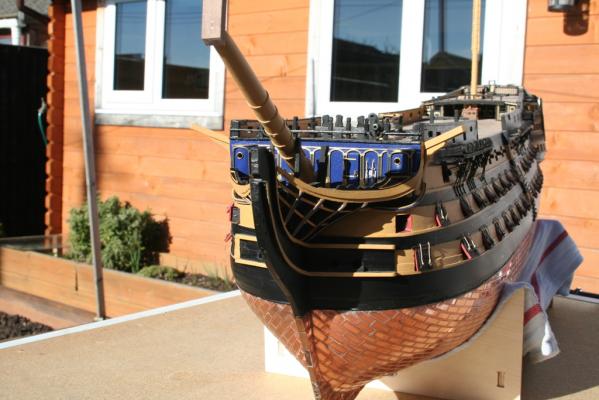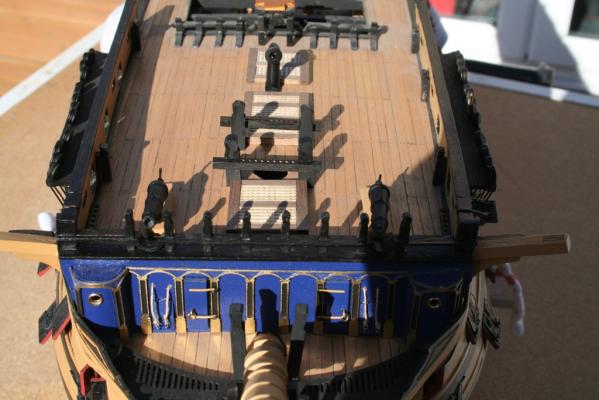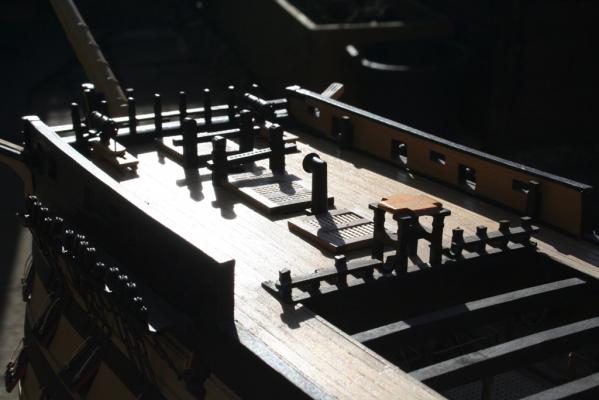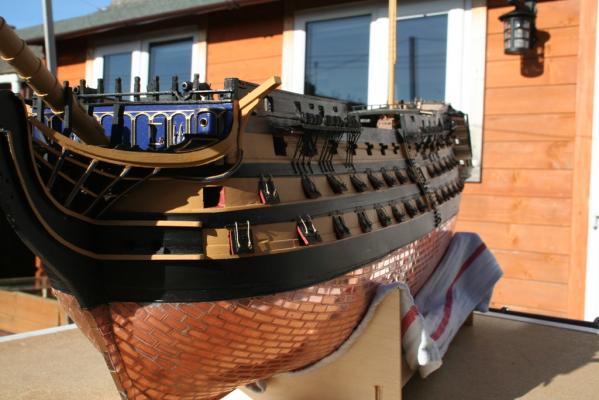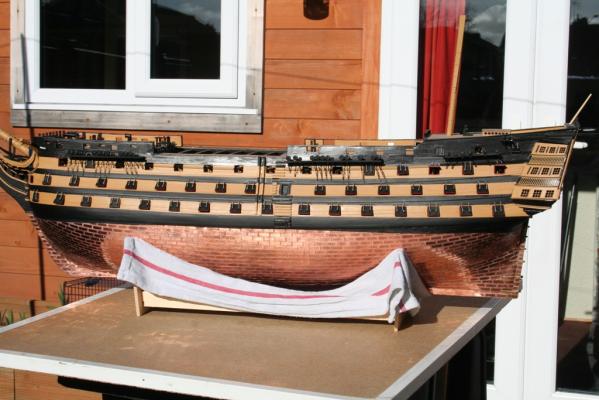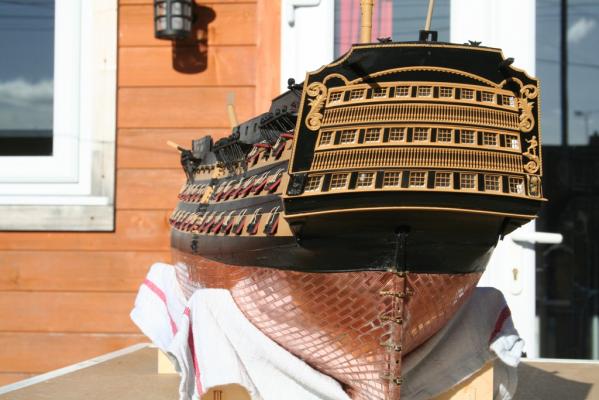-
Posts
7,006 -
Joined
-
Last visited
Content Type
Profiles
Forums
Gallery
Events
Everything posted by Kevin
-
Good afternoon, some progress on my build, the fore deck is complete with the exception of the cannons. I t has taken a little while to get back into it, not being 100% and the weather here, like in many other places has been - well - poor nothing is fixed into position yet, hence some bits look not quite level - good to be back
- 1,319 replies
-
- caldercraft
- Victory
-
(and 1 more)
Tagged with:
-
16th February 1745 HMS Weymouth (60), Cptn. Warwick Calmady, grounded and wrecked off English Harbour, Antigua 1793 HMS Iphigenia (32), Cptn. Patrick Sinclair, captures the French privateer Elizabeth in the Channel 1798 Boats of HMS Alfred (74), Cptn. T. Totty, captured Scipion. 1804 Lt. Stephen Decatur USN leads Tripoli raid to burn the captured frigate Philadelphia. 1815 USS Constitution (44), Cptn. Charles Stewart, captured British merchantman Susannah
-
15th February 1775 HMS Halifax schooner (10) wrecked. 1793 HM Brig Sloop Childers (16), Robert Barlow, captures the French privateer Patriote near Gravelines in the first capture of the Revolutionay War 1808 HMS Raposo gun-brig, Lt. James Violett, burnt to avoid capture near Carthagena. 1809 HMS Belle Poule (38), Cptn. James Brisbane, captured French frigate Var (26) in the Gulf of Valona, Adriatic 1811 HMS Amethyst (36), Cptn. Jacob Walton, driven ashore and wrecked on Cony Cliffs, Plymouth Sound, by a violent gust of wind.
-
14th February 1760 HMS Ramillies (90) driven ashore and wrecked in what is today Ramillies Cove near Salcombe, Devon 1778 John Paul Jones in Ranger receives first official salute to U.S. Stars and Strips flag by European country, at Quiberon, France. 1779 Captain Cook killed 1797 Battle of Cape St. Vincent. British fleet, under Sir John Jervis, defeated Spanish fleet, under Jose de Cordoba 1805 HMS San Fiorenzo (38), Cptn. Henry Lambert, captured French frigate Psyche, Capt. Bergeret, off Vishakhapatnam in the Indian Ocean. 1807 HMS Bacchante (22), Cptn. James R. Dacres, and HMS Mediator (44), Cptn. William Furlong Wise, captured the French national schooner Dauphin (3) off Cape Raphael and used her to to get the ships into and attack her home port of Samana, St Domingo. The fort was carried and destroyed and 2 privateers and 2 prizes in the harbour were taken. HMS Ajax (74), Cptn. Henry Blackwood, burnt by accident off the Island of Tenedos in the Dardanelles. 1810 HMS Rainbow (28) and HMS Avon (18), Henry Fraser, engaged French frigate Nereide (44) 1813 USS Essex becomes first U.S. warship to round Cape Horn and enter the Pacific Ocean. Boats of HMS Bacchante (38), Cptn. William Hoste, captured French gunboat Alcinous (2) taken off Otranto with eight trading vessels under her convoy. 1814 USS Constitution (44), Cptn. Charles Stewart, captured HMS Pictou schooner (16) and armerd merchantLovely Ann. Pictou was destroyed.
-
http://www.euromodel-ship.com/eng/index.php#axzz2tCs7v4OX
-
13th February 1801 HMS Success (32), Cptn. Shuldham Peard, captured by French squadron under Rear Ad. Gantheaume near Toulon 1808 Boats of HMS Confiance (20), Cptn. James Lucas Yeo, cut out a French gunboat, Enseigne Gaudolphe, off the Tagus. HMS Bassora Brig (12), James Violet, wrecked near Carthagena. 1811 HMS Pandora (18), John Macpherson Ferguson, struck the Scaw Reef off Jutland and was wrecked. 1812 HMS Apollo (38), Cptn. Bridges W. Taylor, took French frigate-built storeship Merinos (20). 1814 HMS Boyne (98), Cptn. Burton, and HMS Caledonia (120), Cptn. Jeremiah Coghlan, engaged Romulus andAdrienne off Toulon Island of Paxo surrendered to HMS Apollo (38), Capt. Bridges W. Taylor, and troops. 1854 Admiral Perry anchors off Yokosuka, Japan to receive Emperor's reply to treaty proposal
-
Welcome - i would recommend the Victory, but like to see another RW in build
-
12th February 1793 HMS Alligator (28), Cptn. William Affleck, captures the French privateer Sans Peur in the North Sea 1807 HMS Atalante (16), Lt. John Bowker, wrecked when running aground on La Grande Blanche, Island of Rhe, France. 1811 HMS Cerberus (32), Cptn. Henry Whitby, and HMS Active (38), Cptn. James Alexander Gordon, take or destroy, under the town of Ortano, Italy, a Venetian trabaccolo and 9 transports.
-
11th February 1744 British Fleet of 30 ships of the line, under Admiral Thomas Mathews, engaged Franco-Spanish fleet of 27 ships of the line, under Juan José Navarro, off Toulon. 1778 HMS Liverpool (28), Cptn. Henry Bellew, driven ashore near Jamaica Bay, Long Island, in thick weather and a heavy sea while taking dispatches from the Delaware to New York 1796 HMS Leda (36) foundered off Madeira
-
10th February 1809 HMS Horatio (44), Cptn. George Scott, and HMS Latona (38), Cptn. Hugh Pigot, captured Junon (40), Cptn. Rousseau (Killed in Action), off the Virgin Islands 1810 HMS Thistle (8), Lt. Peter Proctor, captured Dutch national corvette Havik (10), Lt. Stirling. 1811 News received in England of the capture of the Isles of Bourbon and France, with their dependencies, and the capture or extirpation of the enemy's entire naval force in those seas, by Major-general Abercrombie, and Commodore Rowley. 1862 Union gunboats destroy Confederate ships at Elizabeth City, NC
-
9th February 1692 HMS Crown Prize (26) lost outside the entrance to Dartmouth Harbour. 1707 HMS Hastings (32), Cptn. Francis Vaughan, capsized off Yarmouth 1746 HMS Portland (50), Cptn. Charles Stevens, captured French Auguste (50) off Scilly 1799 USS Constellation, (38) Cptn. Thomas Truxtun, captures French l'Insurgente (36), Captain Barreaut, off the island of Nevis. HMS Daedalus (32), Cptn. Henry Lidgbird Ball, captured Prudente (38) near the Cape of Good Hope. 1808 HMS Decouverte (8), Lt. Colin Campbell, captured French armed schooner Dorade (3), Cptn. Netley, off St. Domingo.
-
8th February 1794 HMS Fortitude (74), Cptn. William Young, and HMS Juno (32) engaged tower on Mortella Point, Corsica an event which eventually led to the construction of 'Martello' towers on the south coast of England. 1804 HMS Hussar (38), Cptn. Philip Wilkinson, struck on the southernmost part of the Saintes, beat over the rocks, carrying away the rudder and was bilged. Burnt to prevent capture. 1805 HMS Curieux (18), George Edmund Byron Bettesworth, captured French privateer brig Dame Ernouf (16) some 60 miles east of Barbados. 1808 Boats of HMS Meleager (36), Cptn. John Broughton, captured French felucca-rigged privateer Renard. off the port of San-Jago de Cuba. 1809 HMS Amphion (32), Cptn. William Hoste, and HMS Redwing (18), Edward Augustus Down, destroyed stores and took two prizes at Meleda, Adriatic. 1813 Boats of HMS Belvidera (36), Cptn. Richard Byron, HMS Maidstone, HMS Junon (38), Cptn. James Sanders, and HMS Statira (38), Cptn. Hassard Stackpoole, took American letter of marque Lottery (6)
-
thank you - but have you seen Gils - http://modelshipworld.com/index.php?/topic/485-hms-victory-by-gil-middleton-jotika-172/?hl=%2Bgil+%2Bmiddleton
- 104 replies
-
- victory
- billing boats
-
(and 1 more)
Tagged with:
-
I needed this link tonight - something i have posted - has been of some use - yipppeeeeeeeeeee http://www.animatedknots.com/knotlist.php?LogoImage=LogoGrog.jpg&Website=www.animatedknots.com
-
are you going to age/weather the build Andy, or just prime and top coat
- 382 replies
-
- stadacona
- sylvan scale models
-
(and 1 more)
Tagged with:
-
At this rate of progress you will have caught up with me by next weekend
- 104 replies
-
- victory
- billing boats
-
(and 1 more)
Tagged with:
-
From on this day 1793 Cptn. Horatio Nelson joins HMS Agamemnon (64). HMS Agamemnon (1781) http://en.wikipedia.org/wiki/HMS_Agamemnon_(1781) Under Nelson In anticipation of the start of Britain's involvement in the French Revolutionary War after the execution of King Louis XVI, Agamemnon was recommissioned on 31 January 1793. She was placed under the command of Captain Horatio Nelson, and after provisioning joined the fleet lying at anchor at the Nore. She subsequently sailed to join the Mediterranean fleet under Vice-Admiral Hood, which was blockading the French port of Toulon.[2] On 27 August the town of Toulon declared its allegiance to the Royalist Bourbon cause, and Hood's fleet moved in to take control of the naval dockyard and the 30 French ships of the line that were in the harbour. After capturing 19 of the ships, Agamemnon was sent to Naples to ask King Ferdinand IV for reinforcements with which to secure the town; he agreed to provide 4,000 men. When the revolutionary army, commanded by Napoleon Buonaparte, launched its assault against Toulon, the troops proved insufficient to hold it, and they were forced to abandon the town.[10] In April and May 1794, seamen from Agamemnon, led by Nelson, helped capture the Corsican town of Bastia. The French surrendered on 21 May, after a 40-day siege. After this action, Agamemnon was forced to sail to Gibraltar to undergo urgent repairs, the ship having become very worn out after just 16 months at sea, despite having undergone a fairly extensive refit just prior to being recommissioned.[2] Upon completion of her repairs, Agamemnon returned to Corsica, anchoring south ofCalvi on 18 June.[10] After Hood arrived with additional ships, Agamemnon contributed guns and men to the 51-day siege of Calvi, during which time Nelson lost the sight in his right eye when a French shot kicked sand and grit into his face. The town surrendered on 10 August, Agamemnon having lost six men in the engagement.[11] Shortly thereafter the inhabitants of Corsica declared themselves to be subjects of His Majesty King George III.[12] Agamemnon, still with the Mediterranean fleet—now under Vice-Admiral William Hotham, who had superseded Hood in December 1794—participated in the Battle of Genoa when a French fleet, comprising 15 ships of the line, was sighted on 10 March 1795. Three days later, the French having shown no signs that they were willing to give battle, Admiral Hotham ordered a general chase. The French ship Ça Iralost her fore and main topmasts when she ran into one of the other ships of the French fleet, Victoire, allowing HMS Inconstant to catch up with and engage her. Agamemnon and Captain came up to assist soon after, and continued firing into the 80-gun French ship until the arrival of more French ships led to Admiral Hotham signalling for the British ships to retreat. Ça Ira was captured the following day, along with Censeur, which was towing her, by Captain and Bedford.[11][12] On 7 July 1795, whilst in company with a small squadron of frigates, Agamemnon was chased by a French fleet of 22 ships of the line and 6 frigates. Due to adverse winds, Admiral Hotham was unable to come to her aid until the following day, and the French fleet was sighted again on 13 July, off the Hyères Islands. Hotham signalled for his 23 ships of the line to give chase, and in the ensuing Battle of the Hyères Islands, Agamemnon was one of the few Royal Navy ships to engage the enemy fleet.[a] The French ship Alcide struck her colours during the battle, only to catch fire and sink. Many of the other French ships were in a similar condition; Agamemnon and Cumberland were manoeuvring to attack a French 80-gun ship when Admiral Hotham signalled his fleet to retreat, allowing the French to escape into the Gulf of Fréjus.[12] Admiral Hotham was later greatly criticised for calling off the battle, and was relieved as Commander-in-Chief in the Mediterranean by Admiral Sir John Jervis at the end of the year.[13] Nelson was promoted to Commodore on 11 March, and on 10 June 1796 transferred his pennant to HMS Captain, Captain John Samuel Smith replacing him as Agamemnon's commander. Having been deemed in great need of repair, the ship then returned to England.[13]
-
7th February 1758 Cptn. Samuel Hood joined HMS Vestal (32). 1793 Cptn. Horatio Nelson joins HMS Agamemnon (64). 1800 USS Essex becomes first U.S. Navy vessel to cross the Equator. 1808 HMS Decouverte (8) drove ashore a privateer. 1810 HMS Achates (10), Thomas Pinto, wrecked at Guadeloupe. 1813 HMS Amelia (38), Cptn. Frederick Paul Irby, engaged French frigate Arethuse (46), Capt. Bouvet, off Sierra Leone 1829 HMS Nightingale (8), Lt. George Wood, wrecked on the Shingles
-
6th February 1799 HMS Argo (44), Capt James Bowen, captured Spanish frigate Santa Teresa (34) off Majorca. 1800 HMS Loire (40), Cptn. James N. Newman, HMS Danae (20), Cptn. Lord Proby, HMS Railleur (20), Cptn Turquand, HMS Fairy (16) and HMS Harpy (18), Henry Bazely, captured French frigate Pallas (38) off Cape Frehel 1806 British aquadron of 7 ships of the line, two frigates and two brigs, under Vice Ad. Sir John Thomas Duckworth, defeated French squadron of five ships of the line, two frigates and a corvette, under Vice-Admiral Corentin Urbain Leissègues, off St. Domingo. 1810 End of campaign with final capture of Guadaloupe by Britsh fleet, under Rear Ad. Sir Alexander Cochrane, of HMS Pompee (80), Capt. George Cockburn, and consorts. 1862 Union gunboat squadron captures Fort Henry, Tennessee River
-
5th February 1744 HMS Looe (44), Cptn. Ashby Utting, foundered off Sable Cape 1800 HMS Fairy (16) and HMS Harpy (18), Henry Bazely, engaged French frigate Pallas (38) off Cape Frehel. She struck to Harpy when HMS Loire (38), HMS Danae (20) and HMS Railleur came up. 1804 HMS Eclair (10), Lt. Carr, engaged French privateer Grand Decide (22) off Tortola. 1807 HMS Blenheim (90), Cptn. Austen Bissell, Vice Ad. Sir Thomas Troubridge, and HMS Java (32), Cptn. George Pigot, lost during a gale off the island of Rodriguez, India Ocean. 1809 HMS Carrier Cutter (10), Lt. Robert Ramsey, was wrecked on the French coast. 1836 HMS Pike (14) wrecked on Pelican Reef in Jamaica.
-
4th February 1779 John Paul Jones takes command of Bonhomme Richard 1804 Boats of HMS Centaur (74), Cpt. Murray Maxwell, cut out French corvette Curieux (16) as she lay under Fort Edward in Port Royal Harbour, Martinique 1811 Four of the enemy's vessels captured off Pestichi, by boats of HMS Cerberus (32), Cptn Henry Whitby, and HMS Active (38), Cptn. James Alexander Gordon. 1825 USS Ferret schooner capsized in a storm off Cuba
About us
Modelshipworld - Advancing Ship Modeling through Research
SSL Secured
Your security is important for us so this Website is SSL-Secured
NRG Mailing Address
Nautical Research Guild
237 South Lincoln Street
Westmont IL, 60559-1917
Model Ship World ® and the MSW logo are Registered Trademarks, and belong to the Nautical Research Guild (United States Patent and Trademark Office: No. 6,929,264 & No. 6,929,274, registered Dec. 20, 2022)
Helpful Links
About the NRG
If you enjoy building ship models that are historically accurate as well as beautiful, then The Nautical Research Guild (NRG) is just right for you.
The Guild is a non-profit educational organization whose mission is to “Advance Ship Modeling Through Research”. We provide support to our members in their efforts to raise the quality of their model ships.
The Nautical Research Guild has published our world-renowned quarterly magazine, The Nautical Research Journal, since 1955. The pages of the Journal are full of articles by accomplished ship modelers who show you how they create those exquisite details on their models, and by maritime historians who show you the correct details to build. The Journal is available in both print and digital editions. Go to the NRG web site (www.thenrg.org) to download a complimentary digital copy of the Journal. The NRG also publishes plan sets, books and compilations of back issues of the Journal and the former Ships in Scale and Model Ship Builder magazines.

